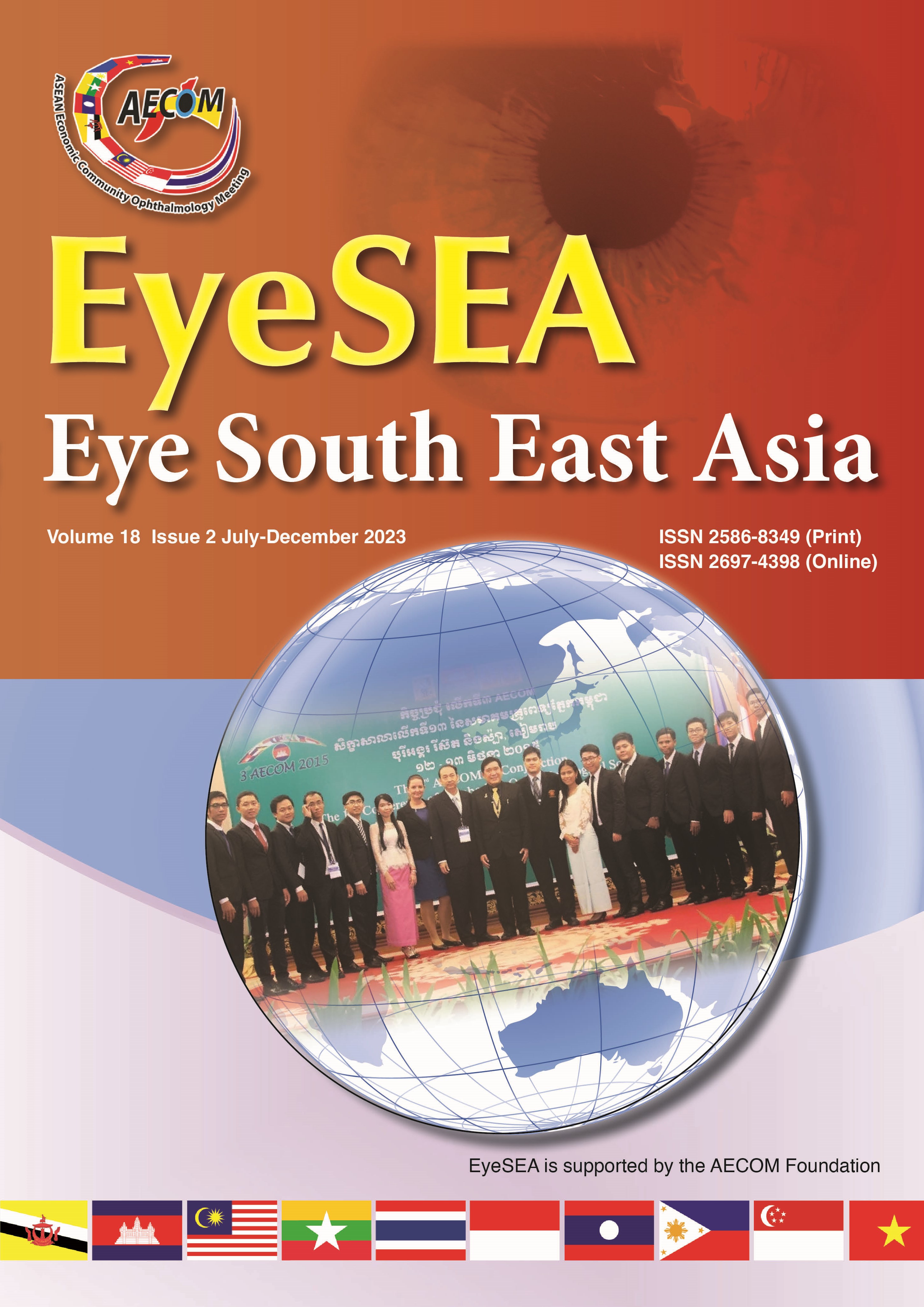Endogenous endophthalmitis: A 5-year Retrospective Study at Thammasat Hospital
Main Article Content
Abstract
Purpose: To study clinical features, risk factors, microbiological characteristics, and visual outcomes in patient with endogenous endophthalmitis
Design: Retrospective, observational case series study
Methods: Review of medical records of 16 patients 18 eyes with endogenous endophthalmitis between 2017 -2022 at Thammasat Hospital which had completed in medical record more than 12 months. The initial visual acuity, underlying disease, method of treatment, method of culture etc. had been recorded. From the results of this study, we compared the treatment outcomes between intravenous antibiotics, pars plana vitrectomy, and a combined method. Endophthalmitis from other causes had been ruled out from the study.
Results: 18 eyes of 16 patients who were diagnosed with endogenous endophthalmitis. Mean(±SD) age was 52.75 (±18.58) years. Mean(±SD) onset was 5.43(±7.44) days. Seventy-five percent of patients had udnerlying disease. The most common risk factor was diabetes mellitus and the most common primary site of infection is the urinary tract. Causative organisms were identified in 87.5% of patients. The most common organism was Streptococcus agalactiae (43.75%). The final visual outcomes were no light perception in 29.41%.
Conclusion: Endogenous endophthalmitis is the cause of severe visual loss. Risk factor of endogenous endophthalmitis comes from various causes but diabetes mellitus is still the most common risk factor. Primary vitrectomy with intravitreal antibiotics may be the better option for treatment than intravitreal antibiotics alone.
Article Details

This work is licensed under a Creative Commons Attribution-NonCommercial-NoDerivatives 4.0 International License.
References
Kernt M, Kampik A. Endophthalmitis: Pathogenesis, clinical presentation, management, and perspectives. Clin Ophthalmol. 2010;4:121-35.
Bhoomibunchoo C, Ratanapakorn T, Sinawat S, Sanguansak T, Moontawee K, Yospaiboon Y. Infectious endophthalmitis: review of 420 cases. Clin Ophthalmol. 2013;7:247-52.
Sadiq MA, Hassan M, Agarwal A, Sarwar S, Toufeeq S, Soliman MK, et al. Endogenous endophthalmitis: diagnosis, management, and prognosis. J Ophthalmic Inflamm Infect. 2015;5(1):32.
Smith SR, Kroll AJ, Lou PL, Ryan EA. Endogenous bacterial and fungal endophthalmitis. Int Ophthalmol Clin. 2007;47(2):173-83.
Chee SP, Jap A. Endogenous endophthalmitis. Curr Opin Ophthalmol. 2001;12(6):464-70.
Schiedler V, Scott IU, Flynn HW, Jr., Davis JL, Benz MS, Miller D. Culture-proven endogenous endophthalmitis: clinical features and visual acuity outcomes. Am J Ophthalmol. 2004;137(4):725-31.
Binder MI, Chua J, Kaiser PK, Procop GW, Isada CM. Endogenous endophthalmitis: an 18-year review of culture-positive cases at a tertiary care center. Medicine (Baltimore). 2003;82(2):97-105.
Lee S, Um T, Joe SG, Hwang JU, Kim JG, Yoon YH, et al. Changes in the clinical features and prognostic factors of endogenous endophthalmitis: fifteen years of clinical experience in Korea. Retina. 2012;32(5):977-84.
Wu ZH, Chan RP, Luk FO, Liu DT, Chan CK, Lam DS, et al. Review of Clinical Features, Microbiological Spectrum, and Treatment Outcomes of Endogenous Endophthalmitis over an 8-Year Period. J Ophthalmol. 2012;2012:265078.
Lim HW, Shin JW, Cho HY, Kim HK, Kang SW, Song SJ, et al. Endogenous endophthalmitis in the Korean population: a six-year retrospective study. Retina. 2014;34(3):592-602.
Ratra D, Saurabh K, Das D, Nachiappan K, Nagpal A, Rishi E, et al. Endogenous Endophthalmitis: A 10-Year Retrospective Study at a Tertiary Hospital in South India. Asia Pac J Ophthalmol (Phila). 2015;4(5):286-92.
Somsiri Sukavatcharin MD, Athicom Benjawechphaisan MD, Wichai Prasartritha, M.D., Makaramas Anantaburana, R.N., B.N.S.2 Endogenous Endophthalmitis: A 10-year review at Ramathibodi Hospital. Thai J Ophthalmol. 2011;January-June 25(1):25-32.
Vilela RC, Vilela L, Vilela P, Vilela R, Motta R, Possa AP, et al. Etiological agents of fungal endophthalmitis: diagnosis and management. Int Ophthalmol. 2014;34(3):707-21.
Celiker H, Kazokoglu H. Ocular culture-proven endogenous endophthalmitis: a 5-year retrospective study of the microorganism spectrum at a tertiary referral center in Turkey. Int Ophthalmol. 2019;39(8):1743-51.
Zhang YQ, Wang WJ. Treatment outcomes after pars plana vitrectomy for endogenous endophthalmitis. Retina. 2005;25(6):746-50.
Jackson TL, Paraskevopoulos T, Georgalas I. Systematic review of 342 cases of endogenous bacterial endophthalmitis. Surv Ophthalmol. 2014;59(6):627-35.
Thanit Sirilekanunt MD. Endogenous Endophthalmitis: Report of a 10-year Retrospective Study at Buriram Hospital. Medical Journal of Srisaket Surin Buriram Hospitals. 2018;33(3):311-20.
Gan LY, Ye JJ, Zhou HY, Min HY, Zheng L. Microbial spectrum and risk factors of endogenous endophthalmitis in a tertiary center of Northern China. Int J Ophthalmol. 2022;15(10):1676-82.
Kuo G, Yen CL, Lu YA, Chen CY, Sun MH, Lin Y, et al. Clinical and visual outcomes following endogenous endophthalmitis: 175 consecutive cases from a tertiary referral center in Taiwan. J Microbiol Immunol Infect. 2022;55(1):114-22.
Khan A, Okhravi N, Lightman S. The eye in systemic sepsis. Clin Med (Lond). 2002;2(5):444-8.
Shankar K, Gyanendra L, Hari S, Narayan SD. Culture proven endogenous bacterial endophthalmitis in apparently healthy individuals. Ocul Immunol Inflamm. 2009;17(6):396-9.
Chen KJ, Sun MH, Chen YP, Chen YH, Wang NK, Liu L, et al. Endogenous Fungal Endophthalmitis: Causative Organisms, Treatments, and Visual Outcomes. J Fungi (Basel). 2022;8(6).
Anand A, Madhavan H, Neelam V, Lily T. Use of polymerase chain reaction in the diagnosis of fungal endophthalmitis. Ophthalmology. 2001;108(2):326-30.
Hong BK, Lee CS, Van Gelder RN, Garg SJ. Emerging techniques for pathogen discovery in endophthalmitis. Curr Opin Ophthalmol. 2015;26(3):221-5.
Jackson TL, Eykyn SJ, Graham EM, Stanford MR. Endogenous bacterial endophthalmitis: a 17-year prospective series and review of 267 reported cases. Surv Ophthalmol. 2003;48(4):403-23.
Buglass TD, Romanchuk KG. Fatal case of group B streptococcal endogenous endophthalmitis. Can J Ophthalmol. 1995;30(3):149-50.
Wu ZH, Chan RP, Luk FO, Liu DT, Chan CK, Lam DS, Lai TY. Review of clinical features, microbiological spectrum, and treatment outcomes of endogenous endophthalmitis over an 8-year period. J Ophthalmol. 2012;2012:265078.
Sim YR, Lee YJ, Park SW, Kim SH, Choi JH, Choi JY, Kim MJ, Sohn JW, Ahn J, Yoon YK. Infective Endocarditis Presenting as Endogenous Endophthalmitis Secondary to Streptococcus agalactiae in a Healthy Adult: Case Report and Literature Review. Infect Chemother. 2017;49(3):241-246.
Danielescu C, Anton N, Stanca HT, Munteanu M. Microbiological, Surgical and Medico-legal Aspects of Endophthalmitis. J Ophthalmol. 2020;2020: 8869590


